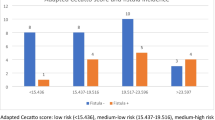Abstract
Pharyngocutaneous fistula after laryngectomy is common and significantly increases the morbidity of the procedure. Intraoperative, objective variables that can reliably predict fistula formation would be useful to surgeons deciding how to reconstruct the laryngectomy defect. Retrospective chart review of 50 radiated patients and 10 non-radiated patients who underwent total laryngectomy at a single tertiary care institution. Patients with pharyngocutaneous fistula were selected to ensure a representative sample were available for comparison. All patients had pathology slides available for re-review by a single, blinded pathologist. Margins of both radiated (n = 50) and non-radiated (n = 10) larynges were examined for 7 histologic features, and odds ratios were calculated to assess whether these features were associated with fistula. When evaluating all 60 patients, both telangiectatic capillaries and hyalinized arterioles were associated with fistula (OR 3.72 and 9.21, respectively). Collinearity between the variables was evaluated; findings indicated a high likelihood of having hyalinized arterioles if telangiectatic capillaries were also present (OR 31.67 [3.13, 320.06]). Microvascular changes in radiated tissue have previously been described in other anatomic subsites, but the larynx and pharynx have not been specifically evaluated. Laryngectomy mucosal margins appear to display similar changes, and evidence of this damage may be associated with fistula formation. These features could potentially guide the surgeon to alter the reconstructive technique.


Similar content being viewed by others

References
Hasan Z, Dwivedi RC, Gunaratne DA, Virk SA, et al. Systematic review and meta-analysis of the complications after salvage total laryngectomy. Eur J Surg Oncol. 2017;43(1):42–51.
Cavalot AL, Gervasio CF, Nazionale G, Albera R, et al. Pharyngocutaneous fistula as a complication of total laryngectomy: review of the literature and analysis of case records. Otolaryngol Head Neck Surg. 2000;123(5):587–92.
Patel UA, Moore BA, Wax M, Rosenthal E, et al. Impact of pharyngeal closure technique on fistula after salvage laryngectomy. JAMA Otolaryngol Head Neck Surg. 2013;139(11):1156–62.
Suzuki S, Yasunaga H, Matsui H, Horiguchi H, et al. Pharyngocutaneous fistula and delay in oral feeding after pharyngolaryngectomy for hypopharyngeal cancer. Head Neck. 2016;38(Suppl):E625–30.
Paydarfar JA, Birkmeyer NJ. Complications in head and neck surgery: a meta-analysis of postlaryngectomy pharyngocutaneous fistula. Arch Otolaryngol Head Neck Surg. 2006;132(1):67–72.
Dirven R, Swinson BD, Beng KG, Clark JR. The assessment of pharyngocutaneous fistula rate in patients treated primarily with definitive radiotherapy following salvage surgery of the larynx and hypopharynx. Laryngoscope. 2009;119(9):1691–95.
Withrow KP, Rosenthal EL, Gourin CG, Peters GE, et al. Free tissue transfer to manage salvage laryngectomy defects after organ preservation. Laryngoscope. 2007;117(5):781–4.
Stone HB, Coleman CN, Anscher MS, McBride WH. Effects of radiation on normal tissue: consequences and mechanisms. Lancet Oncol. 2003;4(9):529–36.
Cooper JS, Fu K, Marks J, Silverman S. Late effects of radiation therapy in the head and neck region. Int J Radiat Oncol Biol Phys. 1995;31(5):1141–64.
Kim H, Park Y. Metastasis via peritumoral lymphatic dilation in oral squamous cell carcinoma. Maxillofac Plast Reconstr Surg. 2014;36(3):85–93.
Grundmann O, Mitchell GC, Limesand KH. Sensitivity of salivary glands to radiation. J Dent Res. 2009;88(10):894–903.
Author information
Authors and Affiliations
Corresponding author
Ethics declarations
Conflict of interest
The authors declare that they have no conflict of interest to disclose.
Rights and permissions
About this article
Cite this article
Abouyared, M., Kerr, D.A., Burroway, B. et al. Abnormal Microvasculature in Laryngectomy Mucosal Margins may be Associated with Increased Risk of Fistula. Head and Neck Pathol 13, 364–370 (2019). https://doi.org/10.1007/s12105-018-0974-7
Received:
Accepted:
Published:
Issue Date:
DOI: https://doi.org/10.1007/s12105-018-0974-7



